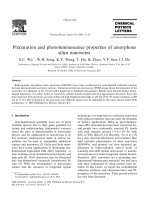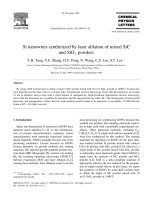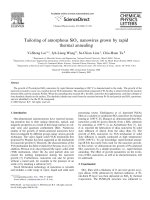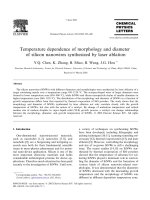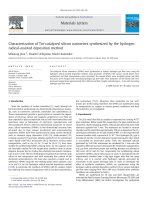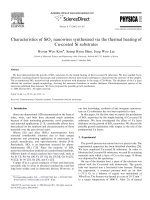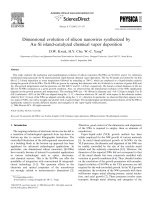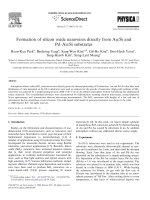- Trang chủ >>
- Khoa Học Tự Nhiên >>
- Vật lý
Synthesis and photoluminescence property of silicon carbon nanowires synthesized by the thermal evaporation method
Bạn đang xem bản rút gọn của tài liệu. Xem và tải ngay bản đầy đủ của tài liệu tại đây (1.07 MB, 5 trang )
Synthesis and photoluminescence property of silicon carbon nanowires
synthesized by the thermal evaporation method
Enlei Zhang
a
, Yuanhong Tang
a,b,
Ã
, Yong Zhang
a
, Chi Guo
a
a
College of Materials Science and Engineering, Hunan University, Changsha 410082, People’s Republic of China
b
Powder Metallurgy Research Institute, Central South University, Changsha 410083, People’s Republic of China
article info
Article history:
Received 13 November 2008
Received in revised form
18 November 2008
Accepted 18 November 2008
Available online 27 November 2008
PACS:
81.07.Bc
81.40.Tv
Keywords:
Nanostructures
Crystal growth
Electron microscopy
Optical properties
abstract
The purity of
b
-SiC nanowires is raised obviously by using an ordered nanoporous anodic aluminum
oxide template by the thermal evaporation method without any m etal catalyst. The microstructures
were characterized by scanning electron microscopy, energy-dispersive X-ray spectroscopy, X-ray
diffraction and high-resolution transmission electron microscopy. The results show that the synthesized
products mainly consist of nanowires, which are single-crystalline
b
-SiC with diameters of about 50 nm
and tens of micrometers long. The nanowires axes lie along the /111S direction and possess a high
density of planar defects. The
b
-SiC nanowires exhibit the strong photoluminescence peaks at
wavelength 400 nm, which is significantly shifted to the blue compared with the reported luminescence
results of SiC materials. The blueshift may be ascribed to morphology, quantum size confinement effects
of the nanomaterials and abundant structure defects that existed in the nanowires. Finally, the growth
mechanism of SiC nanowires and the effect of anodic aluminum oxide template are also analyzed and
discussed.
& 2008 Elsevier B.V. All rights reserved.
1. Introduction
Recently, one-dimensional structures such as wires, rods, belts
and tubes have become the focus of intensive research because of
their unique applications in functional materials and the fabrica-
tions of the nanoscale devices [1–3]. As an important wide band-
gap semiconductor with high electron mobility, SiC nanowires
would be favorable for applications in high-temperature, high-
power and high-frequency nanoscale devices [4]. Recent results
[5] show that the elasticity and strength of SiC nanowires are
considerably greater than those of SiC whiskers and bulk SiC.
A variety of methods on the synthesis of SiC nanowires have
been developed, including laser ablation [6,7], chemical vapor
deposition via silicon precursor [8–11], physical evaporation,
hydrothermal method [12,13] and catalyst-assisted vapor liquid
solid mechanism [14]. However, these products are available at
the cost of either high pure and expensive carbon nanotube or the
hazardous and easily explosive silicon (carbon) precursor of SiH
4
or SiCl
4
(CH
4
). In addition, the synthesized products were of low
yield and with much SiC bulk. Thus, large-scale synthesis of pure
b
-SiC nanowires still remains a challenge to be considered for the
above-mentioned disadvantage.
In this work, we have developed a simple method for
synthesizing large-scale pure
b
-SiC nanowires by heat-activated
carbon with SiO powders using anodic aluminum oxide (AAO)
template without any metal catalyst. SiO powders cannot react
with activated carbon directly because of AAO template. The
synthesized SiC nanowires were of high yield without much bulk.
The synthesized nanowires consist about 50 nm diameter core
wrapped with an amorphous SiO
2
sheath. The crystal growth
direction /111S is clearly observed. Photoluminescence spec-
trum centered at 400 nm is referred to the SiC nanowires. Based
on an analysis of experimental conditions, a growth mechanism
and the effect of AAO template are proposed to explain the
formation of pure SiC nanowires.
2. Experimental
2.1. Fabrication process of the AAO template
The AAO template was prepared by a two-step aluminum
anodic oxidation process similar to that previously described, to
obtain a uniform pore structure [15,16]. Prior to anodization, the
high-purity aluminum thin sheets (99.99%) were annealed at
600 1C for 2 h, rinsed in distilled water and then electropolished to
ARTICLE IN PRESS
Contents lists available at ScienceDirect
journal homepage: www.elsevier.com/locate/physe
Physica E
1386-9477/$ - see front matter & 2008 Elsevier B.V. All rights reserved.
doi:10.1016/j.physe.2008.11.004
Ã
Corresponding author at: College of Materials Science and Engineering, Hunan
University, Changsha 410082, People’s Republic of China. Tel./fax: +86 7318821778.
E-mail address: (Y.H. Tang).
Physica E 41 (2009) 655–659
achieve a smooth surface. Subsequently, the aluminum samples
were anodized in 0.3 M oxalic acid (40 V, 17 1C, 6 h and Al sheet as
an anode). In the first step, anodized layer was removed by
etching in a mixture of phosphoric acid and chromic acid at 60 1C
for 12 h. During the second step, the samples rinsed in distilled
water and oxalic acid were anodized again in 0.3 M oxalic acid
(40 V, 16 1C, 10 h and Al sheet as an anode). After the second-step
anodization, the unwanted aluminum matrix was dissolved in
saturated CuCl
2
solution at room temperature. Finally, the
template was rinsed with distilled water and immersed in 5%
phosphoric acid for about 30 min at room temperature to adjust
the pore diameter and remove the barrier layer at the bottom of
nanoholes.
2.2. Synthesis of SiC nanowires
The preparation apparatus for synthesis of SiC nanowires is a
conventional furnace with horizontal alumina tube. Solid SiO
powders (1 g, purity 99.9%) were placed in a graphite crucible and
covered with an AAO template. The activated carbon (2 g) was
placed on the AAO template. Then, the crucible was covered with
a graphite lid, placed in the hot zone inside the alumina tube, as
shown in Fig. 1. The chamber was flushed with high purity of Ar
(40 sccm) to eliminate O
2
by means of rotary vacuum pump for
many times. Afterwards, the furnace was rapidly heated from
room temperature to 1400 1C at a heating rate of 10 1C/min and
maintained for reaction for 2 h in atmosphere pressure. The
sample was taken out when it was cooled down to room
temperature, and the AAO template surface was deposited with
thick layer of light-blue fluffylike products.
Morphology and crystal lattice of the samples were observed
by field-emission transmission electron microscopy (TEM, JEOJ
JSM-5600LV) and high-resolution transmission electron micro-
scopy (HR-TEM, JEOL JEM-3010). The crystalline structure was
analyzed by X-ray diffraction (XRD, Semens D5000). The possible
chemical composition of as-grown products was investigated by
energy-dispersive X-ray spectroscopy (EDS) attached to the TEM.
The IR measurement was completed on a WQF-410 spectrometer
with a resolution of 0.65 cm
À1
. Phtotoluminescence (PL, Hitatch
F-4500) spectroscopy measurement was performed with xenon
lamp under 354 nm as the excitation source at room temperature.
3. Results and discussion
A typical SEM image of the nanoporous AAO template
surface is shown in Fig. 2. The image shows the nanopores on
the surface with an average pore diameter of about 50 nm, which
are connected to each other to form the nanonetwork. Fig. 3a
ARTICLE IN PRESS
Fig. 1. Schematic illustration of synthesized b-SiC nanowires.
Fig. 2. SEM image of the nanoporous AAO template surface.
Fig. 3. SEM image of b-SiC nanowires synthesized by thermal evaporation: (a)
with the AAO template and (b) without the AAO template.
E.L. Zhang et al. / Physica E 41 (2009) 655–659656
displays SEM image of SiC nanowires synthesized using the AAO
template by thermal evaporation. It reveals that large quantities of
randomly distributed wire-like products have been obtained. The
nanowires are of uniform diameter of about 50 nm and lengths up
to tens of micrometers. In addition, it is very important to put the
AAO template over SiO powders. To test this, we removed the AAO
template to repeat the above process, and much more bulk was
found, as shown in Fig. 3b. We think that silica source could not
react with activated carbon directly because of using AAO
template, and the template made the concentration of the SiO
vapor increase. Thus, overgrowth of the nanowires became
possible by using AAO template.
The X-ray diffraction pattern for the obtained sample is shown
in Fig. 4. As can be seen from the pattern, the major diffraction
peak can be indexed as the (111), (2 0 0), (2 2 0), (311) and (2 2 2)
reflections of cubic
b
-SiC (unit cell parameter
a
¼ 0.4389 nm).
These values are almost identical to the known values for
b
-SiC
(JCPDS Card no. 73-1665).
The internal structure of SiC nanowires was characterized by
TEM. Fig. 5a displays a typical TEM image of the SiC nanowires,
revealing that the periphery of SiC nanowires is very clean and
straight. It also shows that the SiC nanowires possess a high
density of planar defects, stacking faults which are perpendicular
to the wires axes, similar to the already reported results [17–19].
With regard to energetic consideration, the formation of stacking
faults during the growth of SiC nanowires is favorable due to the
contribution of stacking faults themselves with lower energy. By
HR-TEM image (Fig. 6) observation, we have found that nanowires
have a crystalcore and an amorphous sheath with thickness about
2 nm. The SiO
2
sheath could be easily removed by etching in
hydrofluoric acid (HF). The thickness of the SiO
2
sheath could be
controlled by changing the etching time. Fig. 6 also shows that the
spacing of lattice fringes is 0.25 nm, corresponding to the {111}
plane spacing, and also indicates that nanowire grows along
/111S direction. The fast Fourier transform (FFT, inset of Fig. 6)
indicates that the nanowires only possess /111S crystal orienta-
tion. The possible chemical composition of the sample was
analyzed through the EDS data recorded from several pure
nanowires (Fig. 5b). The presence of peaks demonstrates that
the nanowires are composed of Si, C and small amount of O. It is
found that the molecular ratio of Si/C/O of the nanowires is about
3:2:2, which corresponds well to the standard SiC and SiO
2
.
The small quantity of oxygen may come from the resident oxide
layer. The IR spectrum of the as-synthesized SiC nanowire samples
(Fig. 7) also shows
b
-SiC characteristic absorption band at
791 cm
À1
and SiO
2
characteristic absorption bands at 470 and
1000 cm
À1
[13,20]. The SiO
2
characteristic absorption peaks are
quite intense possibly due to the SiO
2
outer layers of the SiC
nanowires; this confirms the composition of nanowires.
To investigate PL properties of the synthesized
b
-SiC nano-
wires, the corresponding measurement was carried out at room
temperature and a PL spectrum (Fig. 8) was obtained. When
excited with light from a xenon source (excitation wavelength
354 nm), the nanowires have an emission band between 330 and
600 nm. It is clear that a strong peak centered at 400 nm is
observed. Compared with previously reported luminescence from
the bulk [21], film [22] and nanowire [23] of SiC, the emission
peak for
b
-SiC nanowires is obviously shifted to the blue. The
emergence of the peak with a blueshift is due to the existence of
oxygen defects in the amorphous layer, the special rough core–
shell interface and the morphology effects such as stacking faults
in the nanowires’ core [24]. It also may be attributed to the
quantum confinement effect because of the small size [23,25].
Clearly, no metal catalyst was employed during the whole
procedure. Thus, the growth mechanism may not follow the
previously reported vapor–liquid–solid (VLS) model. On the basis
of experiments, we suggest a possible growth model for
b
-SiC
nanowires. The chemical reaction equations during the process
can be described as in the following.
ARTICLE IN PRESS
700
600
500
400
300
200
100
0
40 60 80
2θ (°)
Intensity (a.u.)
β-Sic
(200)
β-Sic
(220)
β-Sic
(111)
β-Sic
(311)
β-Sic
(222)
Fig. 4. XRD pattern of the as-received samples.
Fig. 5. (a) TEM image of b-SiC nanowires. (b) The EDS spectrum of b-SiC nanowire.
E.L. Zhang et al. / Physica E 41 (2009) 655–659 657
When the furnace is heated to a high temperature, SiO vapor is
generated, and SiO gas pressure can be maintained much higher in
the graphite crucible. Hence, under very high SiO partial pressure
the disproportionation reaction of gaseous SiO into Si and SiO
2
can
take place according to the reaction (1). It was found that if the
concentration of the vapor was high, overgrowth of the nanowires
became possible [26]. According to the oxide-assisted growth
mechanism, silica decomposed from SiO is believed to play an
important role, significantly enhancing the nucleation and one-
dimensional growth of Si nanowires, which are clothed with a
SiO
2
sheath
2SiOðgÞ!SiðsÞþSiO
2
ðsÞ (1)
where s and g in the brackets refer to solid and gas state,
respectively. The reaction temperature being 1400 1C, the Si
nanowires with a SiO
2
sheath as templates would react with
activated carbon to form SiC nanowires according to the following
reactions (2) and (3):
SiðsÞþCðsÞ!SiCðsÞ (2)
SiO
2
ðsÞþ3CðsÞ!SiCðsÞþ2COðgÞ (3)
In fact, reaction (3) proceeds through two stages in which a
gaseous intermediate SiO gas is generated according to the
following reaction (4). Once CO is formed, SiO maybe produced
according to reaction (5):
SiO
2
ðsÞþ2CðsÞ!SiOðgÞþCOðgÞ (4)
SiO
2
ðsÞþCOðgÞ!SiOðgÞþCO
2
ðgÞ (5)
The SiO vapor formed in above steps subsequently reacts
further with carbon and CO according to the following reaction:
SiOðgÞþ2CðsÞ!SiCðsÞþCOðgÞ (6)
SiOðgÞþ3COðgÞ!SiCðsÞþ2CO
2
ðgÞ (7)
According to thermodynamics calculation for reactions (6) and
(7), the standard free energy changes are approximately À77.4 and
À39.2 kJ/mol at 1400 1C, respectively. Therefore, both reactions
should proceed. The generated CO
2
vapor can be taken into
reaction (8) leading to the formation of CO vapor.
CO
2
ðgÞþCðsÞ!2COðgÞ (8)
During the cooling stage, reaction (9) can occur,
SiOðgÞþCOðgÞ!SiCðsÞþ2SiO
2
ðsÞ (9)
Since SiC has much higher melting point than SiO
2
, the
solidification of SiC occurs faster than that of SiO
2
and the
amorphous, viscous SiO
2
may enclose the crystalline SiC nano-
wires [27,28]. This reaction leads to the decrease in enthalpy and
Gibbs energy at temperature below 900 1C. As compared with
reactions (2) and (3), this reaction is thermodynamically favor-
able, and produces large mounts of SiC/SiO
2
composite nanowires.
ARTICLE IN PRESS
Fig. 6. HR-TEM image of b-SiC nanowire. The inset is the corresponding fast
Fourier transform (FFT).
Fig. 7. IR spectrum of the as-synthesized SiC nanowires sample.
Fig. 8. Room-temperature PL spectrum of b-SiC nanowires.
E.L. Zhang et al. / Physica E 41 (2009) 655–659658
4. Conclusions
In summary, scales of pure crystalline
b
-SiC nanowires with
diameters about 50 nm were synthesized using AAO template by
direct thermal evaporation without any metal catalyst at high
temperature. The as-synthesized products mainly consist of
b
-SiC
nanowires. By means of XRD, SEM, EDS, IR and TEM (HR-TEM),
b
-SiC nanowires have been characterized and discussed in detail.
The growth direction of nanowires lies along the /111S
direction. The tentative growth model according to the SiC
nanowires growth process was suggested. Finally, optical property
is found in the photoluminescence emission from
b
-SiC nano-
wires, which is different from previous observations of SiC
materials. We believe that the pure crystalline
b
-SiC nanowires
with a small diameter described herewith will express excellent in
fields of high mechanical strength material, and will be of use for
application in electronic circuits, in light-emitting devices and in
other advanced blocks of nanodevices.
Acknowledgements
This research work is supported by the Creative Research
Group of National Science Foundation of China (Grant no.
50721003), the Foundation of the Ministry of Education of China
for Returned Scholars (Grant no. 2005383) and the National Basic
Research Program of China (Grant no. 2006CB933000).
References
[1] Z.L. Wang, Adv. Mater. 12 (2000) 1295.
[2] Y. Xia, P. Yang, Y. Sun, Y. Wu, B. Mayers, B. Gates, Y. Yin, F. Kim, H. Yan, Adv.
Mater. 15 (2003) 353.
[3] W.M. Zhou, Z.X. Yang, F. Zhu, Y.F. Zhang, Physica E 31 (2006) 9.
[4] W.M. Zhou, L.J. Yan, Y. Wang, Y.F. Zhang, Appl. Phys. Lett. 89 (2006)
13105.
[5] Z. Pan, H.L. Lai, F.C.K. Au, X. Duan, W. Zhou, W. Shi, N. Wang, C.S. Lee, N.B.
Wong, S.T. Lee, S. Xie, Adv. Mater. 12 (2000) 1186.
[6] A.M. Morales, C.M. Lieber, Science 279 (1998) 208.
[7] D.P. Yu, C.S. Lee, I. Bello, X.S. Sun, Y.H. Tang, G.W. Zhou, Z.G. Bai, Z. Zhang,
S.Q. Feng, Solid State Commun. 105 (1998) 403.
[8] Z.S. Wu, S.Z. Deng, N.S. Xu, C. Jian, J. Zhou, C. Jun, Appl. Phys. Lett. 80 (2002)
3829.
[9] B.Q. Wei, J.W. Ward, R. Vajtai, P.M. Ajayan, R. Ma, G. Ramanath, Chem. Phys.
Lett. 354 (2002) 264.
[10] J. Wei, K.Z. Li, H.J. Li, Q.G. Fu, L. Zhang, Chem. Phys. 95 (2006) 140.
[11] K. Saulig.Wenger, D. Cornu, F. Chassagneux, G. Ferro, T. Epicier, P. Miele, Solid
State Commun. 124 (2002) 157.
[12] L.Z. Pei, Y.H. Tang, Y.W. Chen, C. Guo, X.X. Li, Y. Yuan, Y. Zhang, J. Appl. Phys. 99
(2006) 114306.
[13] L.Z. Pei, Y.H. Tang, X.Q. Zhao, Y.W. Chen, J. Mater. Sci. 42 (2007)
5068.
[14] X.T. Zhou, N. Wang, F.C.K. Au, H.L. Lai, H.Y. Peng, I. Bello, C.S. Lee, S.T. Lee,
Mater. Sci. Eng. A 286 (200 0) 119.
[15] T.E. Bogart, S. Dey, K.K. Lew, S.E. Mohney, J.M. Redwing, Adv. Mater. 17 (2005)
114.
[16] Z. Li, J. Zhang, A. Meng, J. Guo, J. Phys. Chem. B 110 (2006) 22382.
[17] Z. Zhang, X.D. Han, Y.F. Zhang, K. Zheng, X.N. Zhang, Y.J. Hao, X.Y. Guo, J. Yuan,
Z.L. Wang, Nano Lett. 7 (2007) 452.
[18] H.W. Shim, H. Huang, Appl. Phys. Lett. 90 (2007) 083106.
[19] S. Perisanu, P. Vincent, A. Ayari, M. Choueib, S.T. Purcell, M. Bechelany,
D. Cornu, Appl. Phys. Lett. 90 (2007) 043113.
[20] H.W. Shin, H.C. Huang, Nanotechnology 18 (2007) 335607.
[21] H. von Berlepsch, C. Bottcher, A. Ouart, C. Burger, S. Dahne, S. Kirstein, J. Phys.
Chem. B 104 (2000) 5255.
[22] M. Il-Shik, C. Gyoujin, Mater. Sci. Eng. C 24 (2004) 301.
[23] H.K. Seong, H.J. Choi, S.K. Lee, J.I. Lee, D.J. Choi, Appl. Phys. Lett. 85 (2004)
1256.
[24] X.M. Liu, K.F. Yao, Nanotechnology 16 (2005) 2932.
[25] H.J. Choi, H.K. Seong, J. Cryst. Growth 269 (2004) 472.
[26] H. Ye, N. Titchenal, Y. Gogotsi, F. Ko, Adv. Mater. 17 (2005) 1531.
[27] S.Z. Deng, Z.B. Li, W.L. Wang, N.S. Xu, Z. Jun, X.G. Zheng, H.T. Xu, C. Jun, J.C. She,
Appl. Phys. Lett. 89 (2006) 23118.
[28] B. Park, Y. Ryu, K. Yong, Surf. Rev. Lett. 11 (2004) 373.
ARTICLE IN PRESS
E.L. Zhang et al. / Physica E 41 (2009) 655–659 659

